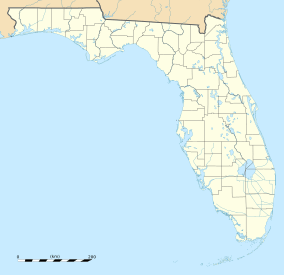Mound Key Archaeological State Park facts for kids
Quick facts for kids Mound Key Archaeological State Park / Mound Key Site |
|
|---|---|
|
IUCN Category IV (Habitat/Species Management Area)
|
|
| Location | Lee County, Florida, USA |
| Nearest city | Fort Myers Beach, Florida |
| Area | 113 acres (0.46 km2) |
| Established | August 12, 1970 |
| Governing body | Florida Department of Environmental Protection |
Mound Key Archaeological State Park is a special island in Estero Bay, Florida. It's managed by the state park system and covers 113 acres. This unique island is made up of ancient mounds. These mounds are more than 30 feet tall! They were built long ago by the Calusa people. Many experts think Mound Key was once the capital city of the Calusa, called Calos. The island is now a protected historic site. You can only reach it by boat from Koreshan State Historic Site or Lovers Key State Park.
Contents
Mound Key: A Historic Island Park
The Calusa People and Their Island Home
Mound Key was created over 2,000 years ago by the Calusa tribe. Scientists have found evidence of Calusa culture here from as far back as 1150 B.C. The island likely started as a low oyster bar in Estero Bay. This area had lots of seafood, which was perfect for the Calusa. They were hunter-gatherers, meaning they found their food from nature.
As more Calusa people lived here, they piled up their food waste. This included shells, fish bones, and broken pottery. These piles are called "middens." Over time, these middens grew into the tall mounds we see today. The Calusa built a complex system of mounds, water courts, and canals. These features are still visible on the island.
The mounds were not just random trash piles. They were carefully built structures. They showed the Calusa's power and were used for religious ceremonies and burials. Mound Key was the main ceremonial center for their kingdom. This kingdom stretched along the southwest coast of Florida. It went from Tampa Bay to the Ten Thousand Islands and east to Lake Okeechobee.
Spanish Arrival and Changes
The arrival of the Spanish in Florida marked a big change for the Calusa. In 1566, Spain's first Governor of Florida was appointed on Mound Key. Soon after, the Spanish built a fort and a settlement there. They also started a mission called San Antón de Carlos. This was the first Jesuit mission in the Spanish New World.
However, there was often conflict between the Spanish and the Calusa. Because of this, the Spanish left the island in 1569. The Spanish also brought diseases that the Calusa people had never encountered. The Calusa had no way to fight these illnesses. These diseases, along with warfare, led to the end of the Calusa civilization around 1750.
Later Inhabitants and Park Creation
After the Calusa, Mound Key was used by many different groups. Pirates, fishermen from Cuba, Portugal, and Spain, and American pioneers lived there at different times.
In 1891, Frank Johnson and his wife, Grandma Johnson, received land on Mound Key. This was part of a new wave of people settling on the island. Grandma Johnson allowed several families to build homes there. She taught them how to fish, farm, and build homes that could handle Florida's heat and storms.
By the early 1900s, most settlers moved to Estero, a town nearby. In 1905, the Johnsons sold the island to the Koreshans. The Koreshans were a group with unique scientific and religious beliefs. They had started a community in the area in 1894.
After their leader, Cyrus Teed, died in 1908, the Koreshan community became smaller. In 1961, the remaining Koreshans gave ownership of Mound Key to the state of Florida. This land was then used to create Mound Key Archaeological State Park. About nine acres of the island remained privately owned by the McGee family until 2019, when Lee County bought their land.
In 2020, archaeologists confirmed that Mound Key was indeed the site of Fort San Antón de Carlos. This Spanish fort was also one of the first Jesuit sites in North America. It was abandoned in 1569. The fort is also the oldest known example of Tabby concrete in North America.
Exploring Mound Key Today
Mound Key Archaeological State Park offers several fun activities. You can enjoy boating, fishing, and watching wildlife. There are also interpretive exhibits to help you learn about the island's history. Nature trails are being developed, but there are no restrooms on the island.
Remember, the only way to get to Mound Key is by boat. You can find interpretive displays along a trail that crosses the island. The park is just a few miles by boat from both the Koreshan State Historic Site and Lovers Key / Carl E. Johnson State Park.


